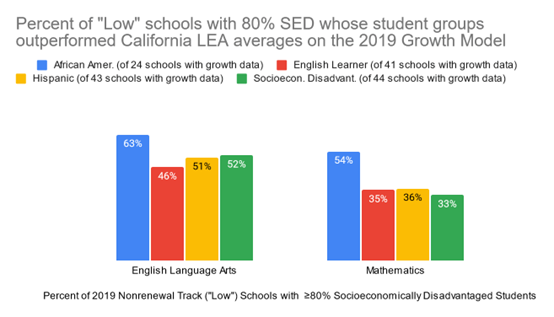Sacramento, CA—On Tuesday, the California Department of Education (CDE) posted its list of 2024 charter school renewal categories based on 2022 and 2023 California School Dashboard data. The list and accompanying guidance play a major role in determining potential charter school closures, not only by naming schools in the presumptive nonrenewal category (the worst of three categories), but also by using the label “Low Performing School.” The label generates unfounded negative misconceptions and digs a deeper hole for such schools.
The “Low Performing School” label does not square with high quality evidence. Over one-third to one-half of low-socioeconomic charter schools in this category (2019) actually achieved higher growth rates than California averages, based on analysis of 2019 California Growth Model data—see CSDC’s related white paper (PDF) for details.

Also, CSDC’s annual review of these categories—including close study of data trends among hundreds of schools every year—shows that a surprising number of schools change categories from year to year. Of 97 schools in the presumptive nonrenewal category in 2023, only thirteen schools landed in the same category on the 2019 list. Fluctuation across the renewal categories is likely due to flawed assumptions in the AB 1505 framework combined with poor fit of Dashboard data to the task.
The intention behind AB 1505, and behind Dashboard-based accountability, is reasonable in theory: to identify low-level, low-growth schools. In practice, however, the Dashboard metrics lack validity and reliability to consistently identify such schools with accuracy. The Dashboard indicates academic level in English Language Arts (ELA) and Mathematics, but not perfectly. More important, the Dashboard does not measure growth, let alone use growth methodology to evaluate school performance. The Dashboard shows no growth metrics for ELA and math whatsoever. The English Language Progress Indicator (ELPI) has the unique benefit of incorporating individual longitudinal progress, but it uses crude methodology based on movement across “performance bands” without distinctions by grade level. This produces considerable volatility in charter schools’ ELPI scores from year to year; it is often the “wild card” in the renewal category outcomes. Finally, the renewal categories are mostly based on comparisons to state averages without matching for same grade span—a significant source of distortion.
These challenges merit a thoughtful response from state leaders. Legislators should ensure that no charter school is tracked for denial without consideration of growth data. In addition, presumptive nonrenewal status should also provide a required check that “closure is in the best interest of students,” as in the default renewal process for so-called middle-performing schools.
At its meeting last week, the State Board of Education (SBE) discussed holding a study session for “deeper thinking” about how state accountability systems are working. Multiple board members contributed helpful ideas in this brief discussion. CSDC looks forward to the results of this work. In the meantime, we hope CDE will provide needed guidance to the field to support more sound data use in renewals—starting with removing inaccurate, damaging labels. The accountability team has a tremendous workload, but providing clear guidance to the field about schools’ ability to grow student learning should be a priority, particularly for schools serving high concentrations of students facing the greatest challenges. For these students especially, we should value and accurately identify high growth schools and take considerable care before setting schools on a path to closure. Getting charter renewal right—and getting school quality evaluation right generally—is a matter of public interest.
Want to learn more? Register now for CSDC’s three-part 2024 Charter Renewal series:
- “Overview of Charter Renewal Process & Renewal Data Fundamentals”—view recording
- “A Closer Look at the Charter Renewal Data Provisions & Criteria”—view recording
- “Compared to What? An Even Closer Look at Renewal Data: Verified Data Growth Methodologies and Evaluating Progress on CAASPP and ELPAC”—participate in webinar April 24, 10:00-11:30AM; register now.
Note: The CDE anticipates posting California Growth Model data at the end of 2024. The State Board anticipates considering how the data may be used on the Dashboard, possibly in 2025. However, the proposed growth model is only for ELA and Mathematics, in grades four through eight, and it is not yet clear how important details will play out, particularly for charter renewal.
Provide Feedback
Please let us know whether you found this helpful or what CSDC could do to improve. We appreciate your time and thoughts!





